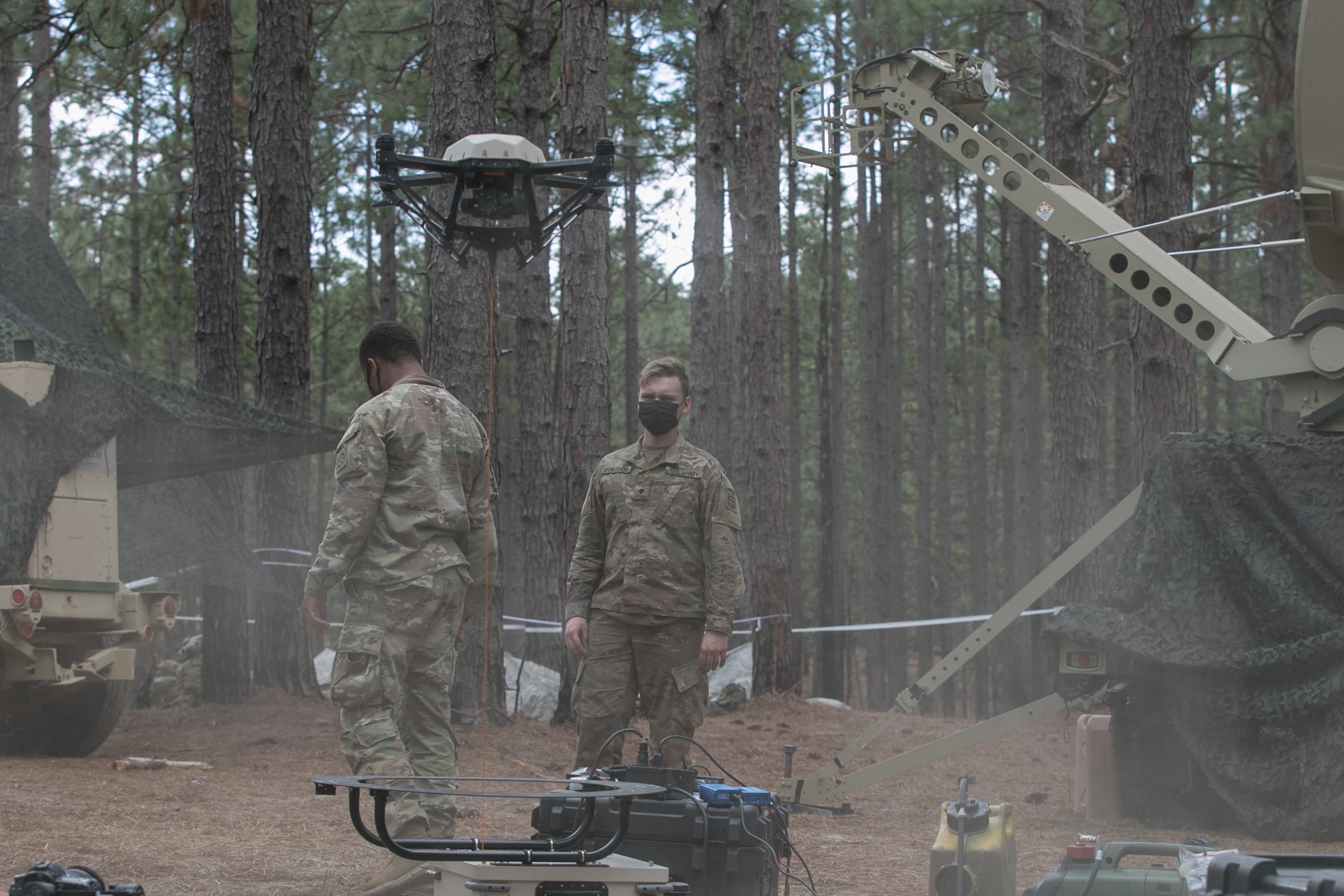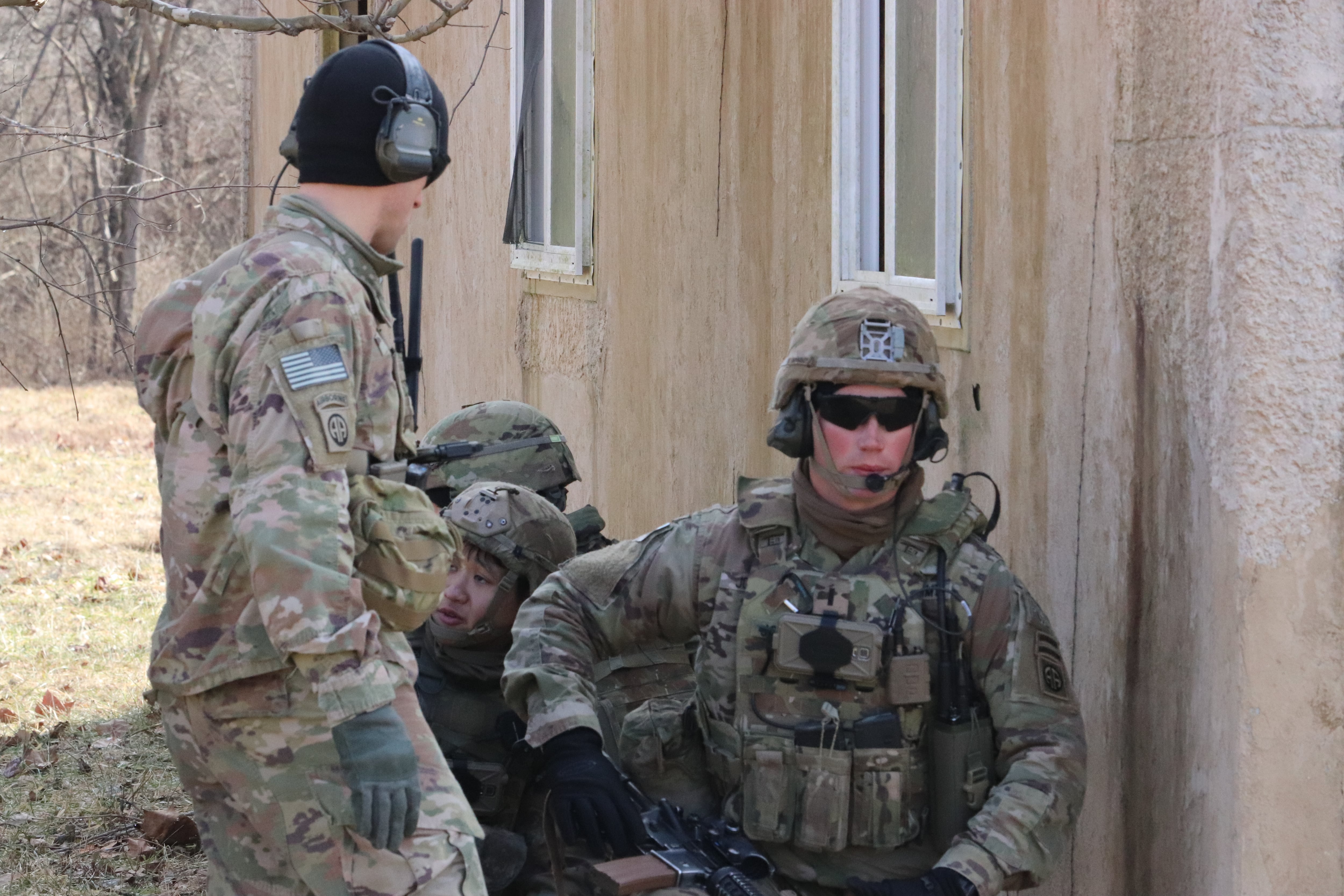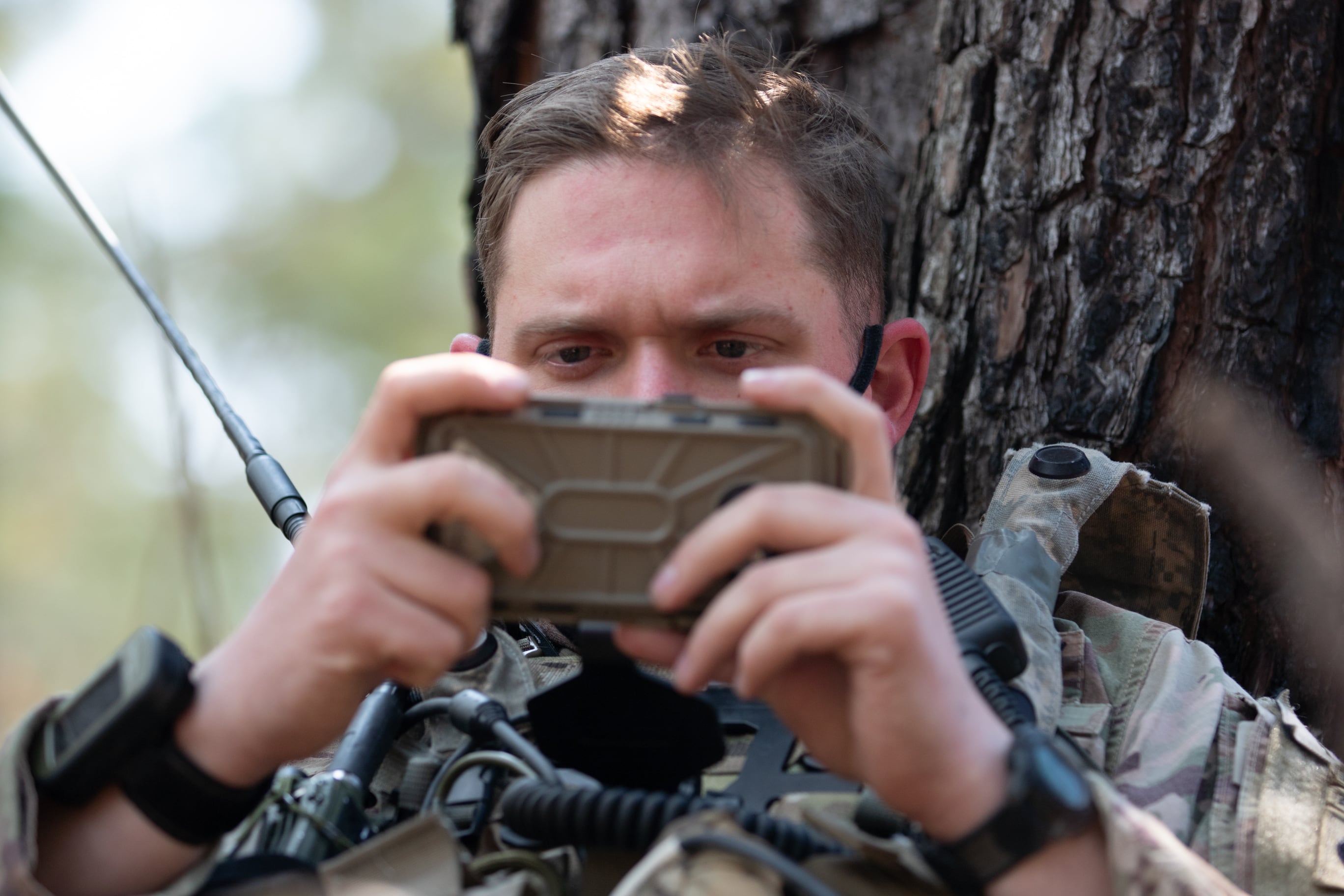WASHINGTON — For the last three and a half years, the U.S. Army’s Network Cross-Functional Team focused on delivering new tools to soldiers to beef up the service’s tactical network capabilities. After delivering the first set to tackle immediate network gaps, known as Capability Set ‘21, the two-star general who launched and shaped the team has retired.
Under the leadership of Maj. Gen. Peter Gallagher, the Network CFT formulated its plan to equip soldiers while working with industry and acquisition partners at Aberdeen Proving Ground, Maryland, to identify future technologies that the Army needs so it can build a resilient battlefield network. The team is currently fielding Capability Set ‘21, designing Capability Set ’23 and planning Capability Set ‘25, all focused on supporting the Joint All-Domain Command and Control concept, or JADC2.
Gallagher retired at the end of May and will be replaced by Brig. Gen. Jeth Rey, the current chief information officer/J6 of U.S. Central Command and former commander of the Hawaii-based 516th Signal Brigade. Rey will bring with him a mix of Middle East and Asia-Pacific experience. In an exit interview with C4ISRNET, Gallagher reflected on his time as the Network CFT director, talked about technology in which the Army must invest and identified hurdles that must be overcome to enable JADC2. This interview has been edited for length and clarity.
The network is the backbone of the Army’s Project Convergence exercise, multidomain operations and JADC2. What were the Network CFT’s biggest accomplishments over last few years?
I would say alignment on the priorities and really driving outcomes to deliver real capability — and in fairly short order. We were able to take the guidance in the very early days from the Army senior leaders and turn it into tangible result and get capabilities out the door, align the resources that allowed us to accomplish our strategy and really pull stakeholders together with the collective alignment to the Army senior leader priorities so that they move at a pace they were uncomfortable with and deliver outcomes they never dreamed possible.
How do you think soldiers can communicate now better than before the Network CFT was set up?
I’m just having come off about a couple different events where I’ve been able to see the results. It’s not perfection; we have not delivered the perfect solution. But we have a solution that is significantly better than what they had in terms of the options provided to our maneuver formations with the integrated tactical network. The radios have multi-connectivity, a multitude of waveforms that they can leverage to their advantage. The mesh networking waveform that we’re using now is significantly more scalable and more survivable and provides better throughput and opportunities for voice and data communications that are unlike anything we’ve had in the past.
From an opportunity to provide options to the maneuver force, I think we’re in a much better place. [Before] the shared situational understanding [capability we delivered to] a maneuver brigade ... it could take hours for them to get 100 percent accountability of their forces as they’re spread out all over the drop zone. With the integrated tactical network, within minutes they can basically have visibility where everybody’s at, and then folks rally within hours. Before it could take hours to just determine where everybody was because [a commander] didn’t have that same level of situational awareness. From that perspective, we made huge strides.
RELATED

How have you upgraded signal formations’ capabilities?
In terms of our signal formations with the expeditionary signal battalion-enhanced, the capability that we’ve leveraged from the joint special operations community provides more tailorable, scalable solutions to our signal formations. Rather than having big systems on big trucks that take big aircraft to deliver capability with the legacy — you know, WIN-T Increment 1 bravo solutions [old network gear] that the signal formations used to have — now they have tailorable solutions that can be taken out [on deployment].
So our signal formations now have a lot more flexibility in what they can provide. They have increased their node count and the number of formations that they can support. In the short order, we’ve really improved the expeditionary capability of our formations, and we’ve provided solutions that are simpler and give them more options. As we go forward here with Capability Set ’23 and the work that’s already being done between the science and technology lab, our program offices, and our team here, we’re at the cusp of leveraging mid-Earth orbit and low-Earth orbit satellite constellations.
How will that help?
These commercial, space-based internet solutions will allow us to have significantly more capacity in our network backbone, much more throughput and resiliency. Some of the waveforms are being enhanced for our radio networks that will give us more resiliency in a contested environment.
How do you use soldier touchpoint events, such as training center rotations, to help inform tactical network decision-making?
We’re leveraging it as a modernization feedback loop for us to see how our Command Post Computing Environment and the Mission Partner Environment are performing and what steps need to be taken by the program management office and the vendor to improve upon those solutions. The approach is sound and solid. With the maneuver formations, leveraging the combat training center rotations [or] getting feedback from the National Training Center, from the heavy units, getting feedback from the Joint Readiness Training Center for the light units, feedback from the second Stryker regiment over in Europe, from the Joint Maneuver Readiness Center over in Europe: That feedback and those force-on-force rotations provide us good insights on how the network performs in a wartime force-on-force scenario, which allows us to make adjustments [and] allows us to go back to the vendors and say, “Hey, look, if only your system could do this or that,” which is very helpful.

It also allows us to make good decisions and recommendations as we go forward on the basis of issue and of quantities because everything in this space has dollar value attached to it, and none of it’s cheap. As we go through the very near future of relooking, the fiscal 2022 budget, and reopening in the fiscal 2023 to 2027 program objective memorandums with planning guidance coming out of the administration, we owe Army senior leaders the best value network that we can recommend, based on what we can field and how we can field to budget.
It’s absolutely important for us to get that feedback from soldiers, from leaders and from those operational units as we work with the collective team of teams between ourselves, the program management office, program executive offices, and the S&T teammates over at the C5ISR Center lab. Without the feedback, a lot of these initiatives would take a lot longer and we would be at the mercy of industry and whatever they deliver, and we really can’t afford to do that. We have to inform industry. We have to hold them accountable to make the changes we need in order to meet the needs of our soldiers so they can fight and win because that’s really what it ends up being all about.
What do you envision as being the most promising future technologies in which the Army must invest in order to ensure it has overmatch on the future battlefield?
It’s got to be constantly investing in network transport. We’ve got to, whether it’s advancing waveforms, whether it’s low Earth orbit, mid-Earth orbit, protected satellite communications modems — the ability to simplify all things in our transport layer to make it a self-healing network when the adversary is trying to contest us in space, cyber and electromagnetic spectrum. That is the absolute most critical element of our strategy. That’s where we’re different than any other sector out there. We’ve got to be able to fight our way through an electronic warfare threat, a cyberthreat, and a threat where we’re going to be contested in the electromagnetic spectrum or space.
So how do we do that? We got to look at every option. So if a technology emerges — it could be free-space optics, for example, our laser kind of solution sets that may lend itself to an alternative network transport — we want to be ready for it. But the only way to make sure we’re ready for it is we must align the focus and the collective energy toward looking at that stuff and make sure that we’re doing our market research. We’ve got our science and technology teammates looking at the next ridge line: Where is industry trending? Where should we be looking in the future? Where’s the Space Force going and the other services? And how can we leverage that to ensure that we have the best possible self-healing network we can deliver? That is where I think we have to make our investment.
RELATED

What capabilities are tied into ensuring the Army gets network transport right?
Advancing waveforms is critical. Improving our scalability and our ability to reduce our electronic signature is absolutely important. Having multiple options, multipath options, whether it’s terrestrial line of sight, aerial tier, beyond line of sight, or multi-orbit space-based solutions, whether it’s low Earth orbit, mid-Earth orbit, or geosynchronous orbit, and having those kinds of options available: To me, that’s the most critical because we got to get the message through. And if we’re contested, that becomes the challenge.
As the Army moves forward with multidomain operations, what does the Network CFT need to do, technologically speaking, to make that vision possible?
In our computing environment, we’ve got to really converge on a common data fabric and simplified applications. Those applications have to be as simple as what you use on a smartphone today on every echelon and make it easy for decision-makers, no matter where they sit, to make decisions with speed. Right now, we’re still a little more clunky and cumbersome than we should be.
I think this is where we’re going to be able to really make a huge difference. In our computing environment, [we need to be] getting that underlying data fabric set and optimizing applications in our edge computing so we can take advantage of emerging algorithms and artificial intelligence/machine learning that help us accelerate the integration of sensors, the integration of effects, and helps us synchronize and integrate in multiple domains and multiple war-fighting functions with speed. So commanders, leaders and battle staff members at every echelon can sense, understand and decide — and act quickly — because they’re not cluttered with a lot of information. They have the information at their fingertips that they need and the applications are simple and easy to use. I think that’s going to be the key.
RELATED

Joint All-Domain Command and Control is a technologically and culturally complex issue for the Pentagon to solve. What are the biggest hurdles the Army and joint force must overcome to enable JADC2?
We all collectively have to get past service parochialism and work together in a way for joint commonality, joint standards, where we’re trying to go with the Joint Staff and with the Office of the Secretary of Defense, chief data officer and also the chief information officer. We believe that the capability set approach that we’re trying to deliver ... that those capabilities sets aren’t unique to the Army. They’re not the answer for everybody, but we believe there’s a need for joint capability sets. We know that all of the services are going to need a mesh network and advanced networking waveforms.
We’re all going to need to be optimized in terrestrial, aerial and space-based connectivity. We’re going to have to have common standards for encryption. We’re going to have to have common standards for data sharing for joint situational understanding and joint fires. So the Army modernization strategy and our lines of effort — our capability set design — is based on where we believe technology will be based on our analysis of the S&T efforts and our analysis of research and development efforts. It doesn’t mean it’s an Army-unique and Army-only solution. What we have to do is kind of give way together here on defining “Where do we need to go as a joint force?” And make sure that the joint leaders — Chairman of the Joint Chiefs of Staff Gen. Mark Milley, Gen. John Hyten and others — collectively agree that: “OK, this is the way we’re going to go with Joint All-Domain Command Control.”
I don’t think any one service has the answer. I think what we have to figure out is what are those service-unique requirements, and then what are those absolute musts [and] joint standards that we all need to connect with and comply with. I think that is going to be the key going forward.
What advice do you have for your replacement as director of the Network CFT?
He’s going to hit the ground running because we’ve been doing a series of deep dives with Gen. Ray. He’s going to come in with a tremendous amount of experience and the depth and breadth of knowledge that’s far different than what I bring to the table. There are things that he’ll do differently. But I would just say that the most important thing is maintaining the continuity and momentum with the team of teams approach. I think that’s going to be the only way a team this small can accomplish the mission this big — by leveraging our relationships. So that is absolutely important.
I think the foundation we’ve established through collaboration, fusion and transparency, which are really the anchor points on which this team was established, those have to remain throughout. As long as he does that and he trusts his instincts and he uses his position as a source of good, he will do great things for the Army going forward.
Andrew Eversden covers all things defense technology for C4ISRNET. He previously reported on federal IT and cybersecurity for Federal Times and Fifth Domain, and worked as a congressional reporting fellow for the Texas Tribune. He was also a Washington intern for the Durango Herald. Andrew is a graduate of American University.








